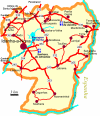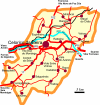|
















|
Historical villages
Almeida
Estrela de Pedra
  There aren’t just stone houses from the most
remotes ages… The strong and magnanimous Estrela de Pedra resists to
time and to those who stayed after the successive invasions.
Nowadays, near the walls, there are flowers and gardens. The houses
sleep behind the tall village walls, as if they were protected. There aren’t just stone houses from the most
remotes ages… The strong and magnanimous Estrela de Pedra resists to
time and to those who stayed after the successive invasions.
Nowadays, near the walls, there are flowers and gardens. The houses
sleep behind the tall village walls, as if they were protected.
When it is seen by plane, Almeida (the way it is
known by its inhabitants), has the shape of a star, powerful in its
surroundings that has protected in its ancient people.
Today the traditions are the one that must be
protected in this historical and beautiful place.
In the paved streets, you can see and scent the
aroma that comes from every kitchen, see the old houses with coat of
arms and ear the legends from the ancient population.
Idanha-a-Velha is 15Km
far from Idanha-a-Nova village, 12Km from Monsanto and 31Km far from
Termas de Monfortinho.
Castelo Mendo
 You can get there by a narrow and tight curves
road. At the arrival, you can see the medieval fortress, surrounded
by green hills and fertile valleys. When you get inside, you’ll
enter in an ancient world: the houses are made of stone with porches
from the poor people, houses that nowadays have another life. You can get there by a narrow and tight curves
road. At the arrival, you can see the medieval fortress, surrounded
by green hills and fertile valleys. When you get inside, you’ll
enter in an ancient world: the houses are made of stone with porches
from the poor people, houses that nowadays have another life.
The village doesn’t care about the progress and
it lives in its own loneliness between mute streets and empty
houses. However this isolation makes of Castelo Mendo a lost
paradise in the mountain.
You can spend here a fine afternoon, tasting a
good and delicious goat cheese and bread, all made by the
traditional ways.
Enjoy yourself in the Church atrium, see an
extraordinary sightseeing and let yourself go in this village
enchants, you will, surely, miss this place...
Located in the
southwest wing from the Almeida district, which is 19KM far from the
village. Castelo Mendo medieval village is implanted on a granite
massif, at 756mt of altitude. Almost inaccessible from the east,
south and west sides, this village has a wild and cut out
sightseeing.
Castelo Novo
Gardunha’s bridge
 It’s a village where you can enjoy the freshness
from Alardo’s water and Gardunha’s healthy air. In the ancient Paços
do Concelho fountain you can even refresh your soul. It’s a village where you can enjoy the freshness
from Alardo’s water and Gardunha’s healthy air. In the ancient Paços
do Concelho fountain you can even refresh your soul.
Enjoy the village and don’t forget to see the
cleaned houses made of stone and decorated with geraniums in the
windowsills; its here where the typical blankets and the articulated
dummies are made.
You will not want to leave…
Located in Beira Baixa, Castelo Novo is halfway
in the east slope of Serra da Gardunha, at 703mt of altitude,
between two creeks.
Castelo Rodrigo
Mysterious ruins
This village has fought the royal wars, it has
survived, and nowadays it struggles to keep its architectonic
beauty, even in ruins. In the top of its walls it has a magnificent
view that goes from Serra da Estrela till Spain. Its greatest charm
is the people that welcome us. Every stonewall that divides the
fields shows us security and a joyful sensation, because it’s
everything in its rightful place. Everyone who visits this village
fells like a Feudal Lord, even if it is for one day.
Idanha-a-Velha
The faith
War
Village or book? Idanha has stories about battles
and warriors that have fought in them. Those who still live here try
to make the village a wanted place to visit. Every house are
original. The Sé and Ruinas are kept as delicate jewels, being the
target of every care and protection needed.The Roman heritage, the
bridge over the Ponsul river, and Torre de Menagem dos Templários
are some of the attractive elements that Idanha has to offer.
Linhares
Between heaven and earth
 The village is beautiful, and every corner has
its story. Going along the village is like going through a book of
memories. However, it’s when it is seen from heaven that it has its
greatness. The aerial sightseeing show us the village outlines, the
surrounding fileds, the colours and the touching silence. Linhares
is a land of tradition that produces cheese, rye bread, it has
flocks and a strong subsistence agricultural component. The village is beautiful, and every corner has
its story. Going along the village is like going through a book of
memories. However, it’s when it is seen from heaven that it has its
greatness. The aerial sightseeing show us the village outlines, the
surrounding fileds, the colours and the touching silence. Linhares
is a land of tradition that produces cheese, rye bread, it has
flocks and a strong subsistence agricultural component.
Its Castle has two towers that remember us the
fights with the enemy in the medieval times. Linhares is at 810mt of
altitude, in one of the foothill of Serra da Estrela, in the
celorico da Beira district, 4Km far from Estrada Nacional 17, which
connects Coimbra to Guarda.
Monsanto
The rock’s strength
It is located in the slope form the Serra and
there great rocks have rise. Once again the geraniums give their
colour to the granite houses. From the exodus only the older people
have escaped, and these are the ones that give a certain enchant to
this place. Walking through the streets we can see stone dorrs and
wooden windows painted with white.
Monsanto is 25Km far from Idanha-a-Nova. The
Access to this village is made by the Estrada Nacional 239 and by
the Estrada Municipal 567.
Sortelha
Stone Ring
 Inside its ancient walls, there are stone houses
carefully recovered. In each corner you can ear stories about the
rural legends.Its streets are narrow and go up through the hills
that grow around the village. From the walls it can be seen
cultivated fields and the houses from the neighbour villages.
Sortelha’s story is very plotted, but its mysteries or the ladies
that make baskets to kill the loneliness, can hook us to this
village. Inside its ancient walls, there are stone houses
carefully recovered. In each corner you can ear stories about the
rural legends.Its streets are narrow and go up through the hills
that grow around the village. From the walls it can be seen
cultivated fields and the houses from the neighbour villages.
Sortelha’s story is very plotted, but its mysteries or the ladies
that make baskets to kill the loneliness, can hook us to this
village.
Marialva
Marialva is one of the historical villages from
our country and it rests a few minutes away from Mêda. This village,
one of the live relics from the ancient times, leads us to the
deepest roots from our history.
When we enter in Marialva, we got the feeling
that we are in a historical scenery, ready to make a medieval movie.
The streets, sided by buildings resistant to time, lead us to the
citadel surrounded by walls, in whose ruins we lost the notion of
time. In its interior it can be enhanced the Square, where it has
the Pelourinho and the building from the Old City Hall, also court
and prison (17th century); there is also the Torre de
Menagem and the Igreja de Santiago.
Piodão
 Piodão is without any doubt one of the most
beautiful villages of Portugal. Classified as public interest since
1978, it has beneficed from some protection. Only since its
integration in the project of Portugal Historical Villages, Piodão
saw its urbanity set kept. Piodão is without any doubt one of the most
beautiful villages of Portugal. Classified as public interest since
1978, it has beneficed from some protection. Only since its
integration in the project of Portugal Historical Villages, Piodão
saw its urbanity set kept.
The village has a shape and a typical disposal of
a mountain village.
 Sheltered from the dominant winds, the houses go
up the hill. The construction materials are those that the land
offers them: slate and wood. The walls have two layers, an exterior
with bigger rocks and an interior with smaller rocks. The roofs have
one or two angles, and some even have four angles of medium
inclination. The blue colour that paints the doors and windows is
still another mystery to resolve, but the most known reason is due
to the village’s isolation and with the arrival of a can of blue
paint. Without another choice, the colour blue was implanted, and it
is actually an integrant part of the architectonic set form the Piodão village. Sheltered from the dominant winds, the houses go
up the hill. The construction materials are those that the land
offers them: slate and wood. The walls have two layers, an exterior
with bigger rocks and an interior with smaller rocks. The roofs have
one or two angles, and some even have four angles of medium
inclination. The blue colour that paints the doors and windows is
still another mystery to resolve, but the most known reason is due
to the village’s isolation and with the arrival of a can of blue
paint. Without another choice, the colour blue was implanted, and it
is actually an integrant part of the architectonic set form the Piodão village.



|